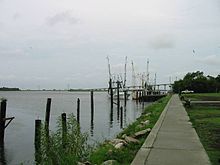Apalachicola, Florida
Gradually, after acquisition by the United States and related development in Alabama and Georgia, it attracted more permanent European-American residents.In 1849, Apalachicola physician John Gorrie discovered the cold-air process of refrigeration and patented an ice machine in 1850.[14] His patent laid the groundwork for development of modern refrigeration and air conditioning, making Florida and the South more livable year-round.Before railroads reached the region in the later 19th century, Apalachicola was the third-busiest port on the Gulf of Mexico (behind New Orleans and Mobile).[14] Scheduled boats transported passengers and goods up and down the Apalachicola, Chattahoochee, and Flint rivers to Albany and Columbus, Georgia.A paddle steamer, the Crescent City, made a daily round trip to Carrabelle, carrying the mail as well as passengers and freight.Originally built in 1935 and rebuilt in 1988, the John Gorrie Memorial Bridge carries U.S. 98 across Apalachicola Bay to Eastpoint.U.S. 98 is the main highway through town, leading east across the bay to Eastpoint and northwest 59 miles (95 km) to Panama City.Today the oyster industry has completely collapsed due to pollution and lack of water flow in the Apalachicola River.In 1979, Exxon relocated their experimental subsea production system from offshore Louisiana to a permitted artificial reef site off Apalachicola.



Apalachicola (disambiguation)Franklin CountyFloridaCountryUnited States of AmericaCountyFranklinSettled (Apalachicola)Settled (Cottonton)Incorporated (Town of West Point)Incorporated (City of Apalachicola)Mayor–CommissionMayor Pro TemCommissionersCity ManagerCity ClerkTime zoneUTC−5Eastern (EST)UTC−4ZIP codesArea codeFIPS codeGNIS IDcounty seatFranklin County, FloridaApalachicola BayGulf of MexicoTrinity Episcopal ChurchJohn GorrieApalachicola ProvinceChattahoochee RiverHitchitiSpanish FloridamissionsApalacheeChatotChipola RiverFrench and Indian WarBritish West FloridaApalachicola RiverAlabamaGeorgiaLegislative Council of the Territory of FloridaprefabricatedAlvan Wentworth ChapmanAmerican Civil WargunboatUSS SagamoreUSS MerceditaUSS Marionwest Floridarefrigerationice machinebody temperatureair conditioningJohn Gorrie MuseumJohn Gorrie Memorial BridgeU.S. 98New OrleansMobileApalachicolaChattahoocheeFlint riversAlbanyColumbus, Georgiapaddle steamerAN RailwayApalachicola Northern RailroadEastpointPanama CityTallahasseeU.S. 319United States Census Bureauhumid subtropicalKöppenApalachicola Regional Airportprecipitationsunshine hoursBlack or African AmericanNative AmericanAlaska NativePacific IslanderNative HawaiianSome other raceTwo or more races/MultiracialHispanic or Latino2020 United States census2010 United States censuscensusAfrican Americanother racesHispanicLatinomarried couplesper capita incomepoverty linerecreational fishingshrimpersFlorida Seafood FestivalSt. Vincent IslandSt. George IslandCape St. George IslandLouisianaartificial reefoil platformEquityFranklin County SchoolsCharter SchoolWallace M. Quinn High SchoolJimmy BloodworthAlvin Wentworth ChapmanMary Rogers GregoryRichard HeyserUnited States Geological SurveyUSS Mercedita historyEncyclopædia BritannicaNational Oceanic and Atmospheric AdministrationAmerican Academy of Underwater SciencesWayback MachineCitiesCarrabelleUnincorporatedcommunitiesAlligator PointBald PointDog Island
